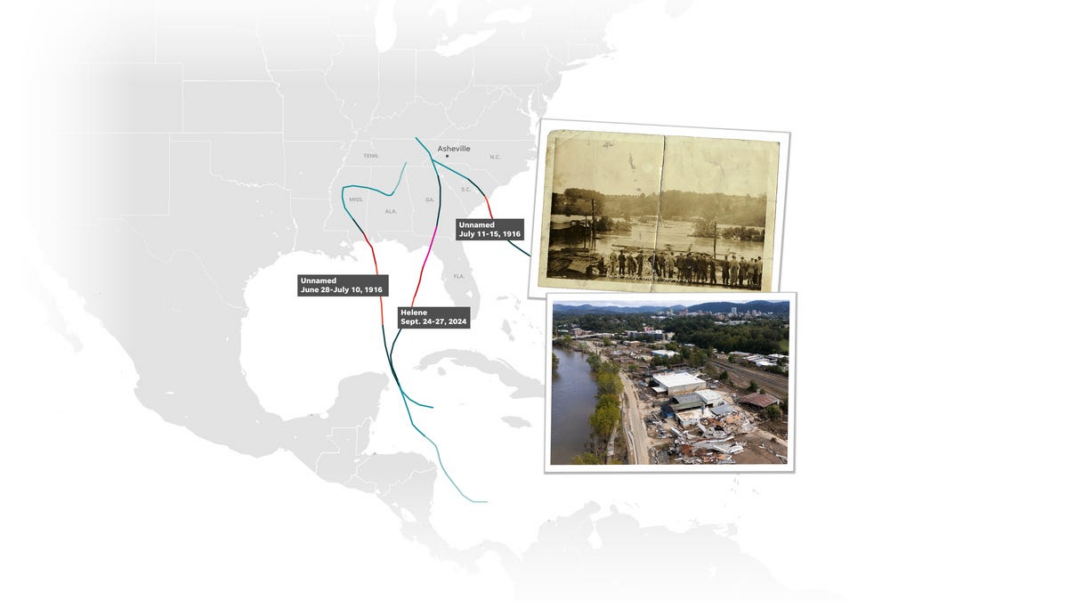Hurricane Helene ravaged Asheville, echoing another disaster 100 years ago
(This story was updated to add new information.)
ASHEVILLE, N.C. − Asheville’s “Great Flood,” of 1916 brought inconceivable devastation to the small mountain town in western North Carolina. What has been described as, “the worst natural disaster in the recorded history of western North Carolina,” killed dozens of residents and completely wiped out roads and railways.
The horror of this distant memory was brought back to life over the weekend as rains brought by Hurricane Helene deluged western North Carolina. Communities on the edge of the Blue Ridge Mountains are left devastated; hundreds of people are missing, thousands are without power and many roads are impassable.
This “100-year flood” is partially due to a rare weather event, some back luck, and potentially climate change, the Asheville Citizen Times reported. There are only estimates about the extent of the destruction, with the full scope of Helene’s devastation not expected to be known for some time, the Citizen Times wrote.
North Carolina Gov. Roy Cooper said Helene had become “One of the worst storms in modern history for parts of North Carolina.”
Over 100 years ago, the “Great Flood” of 1916 crested at 21 feet, a record that has now been smashed by Helene. Here’s how Asheville’s historic flood compares to the devastation caused by Helene in western North Carolina:
How did Asheville’s “Great Flood” of 1916 unfold?
What began as weeks of continuous rain, turned into what has been called, “the worst natural disaster in the recorded history of western North Carolina.” The catastrophic North Carolina flood of 1916 wreaked immeasurable havoc on the region, killing dozens and wiping out roads and railways.
According to the National Weather Service, a storm system made landfall in Alabama on July 5, 1916, producing heavy, relentless rainfall over the North Carolina foothills and mountains. Although no flooding was caused by the initial storm, the ground became heavily saturated and bodies of water were running high.
Then the second storm hit.
On July 14, a Category 2 hurricane made landfall on the South Carolina coast, before reaching the North Carolina mountains on July 15. Record rainfall was widespread. Reports state that between July 15-16, 22.22 inches of rain fell over parts of western North Carolina.
“The water that thundered in its wake wasn’t just ‘high’; it carved away the ground under mountain railroad passes, leaving tracks looking like sky-high trapeze rigs hanging 20 to 60 feet in the air,” the city of Asheville reported.
Reports estimate that around 80 people were killed in the flood of 1916, however, the figure is estimated to be higher. According to the Statesville Record and Landmark, over 20 people died when a single bridge collapsed at Catawba, taking the lives of 14 railway employees, four telegraph employees, and half a dozen onlookers.
“It was more than a universal cloudburst in all this mountain country,” reported the Newton Enterprise back in July 25, 1916. “It was a night of tempest and terror.”
Flooding from Helene brings widespread destruction
Helene dumped nearly 14 inches of rain through Sept. 27, on cities along the Blue Ridge Mountains, including Asheville.
Other areas of North Carolina reported more than 2 feet of rainfall, with Busick receiving nearly 31 inches and Spruce Pine recording 24.12 inches through 8 a.m. Sept. 28.
Officials in North Carolina said they have confirmed at least 88 storm-related deaths. Buncombe County, home to Asheville, has reported 40 deaths, but more are expected.
YSL News reported that hundreds of homes and scores of roads were damaged or destroyed in the floods. Many neighborhoods in western North Carolina have no electricity or running water.
AccuWeather estimates that the cost of total damage and economic loss from Hurricane Helene is between $225 and $250 billion. This includes destruction along the Florida coast and in the Southeast.
According to 1916 reports from the Winston-Salem Journal, the flood caused millions of dollars worth of damage, with the damage to crops alone being worth several hundred thousands of dollars.
“It can be said with safety that no such damage has ever before been brought by flood in the western half of North Carolina,” wrote the Winston-Salem Journal about the Great Flood of 1916. “Indeed, no one thought this section of the state could ever suffer such damage.”
Over 100 years later, western North Carolina is left devastated from one of the deadliest storms in its history. Helene is now the deadliest hurricane to make landfall in the US mainland since Katrina hit in 2005.

